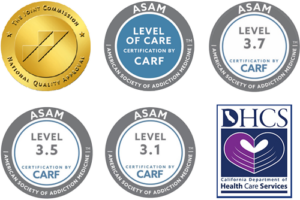How Long Does Cocaine Stay in Urine?
If you are looking for how long cocaine stays in your system you are in the right place. Journey Hillside Tarzana has worked with hundreds of individuals to overcome their addiction and conquer their substance abuse. Continue reading to learn more about the cocaine detection window.
So, How Long Does Cocaine Stay in Urine?
To answer, “How long does cocaine stay in urine,” it helps to understand how cocaine is metabolized in the body. The drug itself is only detected in the urine for a short time, maybe up to three days.
However, the liver breaks down the cocaine and releases metabolites. The main one is called benzoylecgonine. Drug tests are designed to detect this metabolite, which can remain in the body for much longer. A level of 300 micrograms per liter of this metabolite will trigger a positive test result.
When screening for cocaine in urine the results can vary widely. How long the drug or its metabolites are present depends on these factors:
- Duration of a cocaine habit. Long-term use takes longer to clear.
- Mode of ingesting the drug: did the person snort, inject, or smoke the cocaine?
- Is there also alcohol in the system?
- The person’s BMI, as metabolites can be stored in fat cells.
In general: One time user, typically detectable for 3-5 days; heavy cocaine dose, up to 7 days; chronic user, cocaine may remain detectable for 5-14 days.
If you are concerned about how long cocaine remains in urine, it may be a sign of addiction. Being aware of the risks linked to cocaine abuse can help you nip a substance problem in the bud.
More About Cocaine Detection
Cocaine is a powerful stimulant drug, and its metabolites are the byproducts of the body processing this substance. Here are some key points about cocaine metabolites, including their types, half-life, and other relevant factors:
Types of Cocaine Metabolites
- Benzoylecgonine: This is the primary metabolite of cocaine and the one most commonly tested for in standard drug tests. It is detectable longer than cocaine itself.
- Ecgonine methyl ester: Another significant metabolite, this compound is also commonly detected in drug tests but has a shorter detection window than benzoylecgonine.
- Norcocaine: This is a minor and active metabolite of cocaine, which is less commonly tested for but is indicative of cocaine use.
Half-Life of Cocaine and Its Metabolites
- Cocaine itself has a very short half-life, typically around 1 hour, which means it is rapidly metabolized and cleared from the body.
- Benzoylecgonine has a longer half-life, approximately 6 hours, but can be detectable in urine for up to 3 days after use in occasional users, and up to 2 weeks in chronic users. Urinary cocaine metabolite benzoylecgonine levels may depend on a variety of circumstances, including body composition, frequency of drug abuse, and how the drug is delivered to the system (injection, smoking, snorting cocaine, or other methods).
Other Factors Influencing Cocaine Metabolism
- Frequency of Use: Chronic and frequent users of cocaine may have longer detection windows due to the accumulation of metabolites in the body.
- Metabolic Rate: Individual metabolic rates can influence how quickly cocaine and its metabolites are processed and eliminated.
- Method of Use: Smoking or injecting cocaine can lead to faster onset and shorter duration of effects compared to snorting, which may slightly alter the metabolic profile.
- Hydration and Kidney Function: Hydration levels and kidney function can affect the concentration of cocaine metabolites in urine, thus influencing test results.
- pH Levels: The pH level of urine can also affect the detection window of cocaine metabolites, with more acidic urine potentially leading to faster elimination.
Understanding these factors can help in interpreting drug test results and in assessing the timing and extent of cocaine use.
Fear of Failing a Drug Test for Work Due to Cocaine Use?
You may have an upcoming drug test and are wondering, “How long does cocaine stay in the urine?” Or you failed a drug test due to cocaine or other drugs and are not sure what to do next. Ultimately, continuing to use cocaine or any other drugs or alcohol is going to eventually ruin your life with social, legal, and work or school-related consequences. We can go on and on about how long cocaine or other substances stay in your system, which we note down below. But if you are reading this and are here because of this specific issue of the consequences of a failed drug test, you probably should reach out to our team of Treatment Specialists to learn about treatment options. Dependency to any substance will eventually destroy your opportunities and your life. Call our team now to reach out for a confidential assessment at (877) 761-2723. Once you have recovered from the drug dependency or cocaine addiction, you will be able to take pre-employment or work-related drug tests and not have to worry about not being hired or having the fear of losing a job or promotion.
What Kinds of Drug Tests Are There? Drug Testing 101
Drug tests are used to detect the presence of drugs or their metabolites in the human body. These tests can be conducted in various contexts, including employment screening, sports, law enforcement, and treatment of substance abuse. Here are some of the most common types of drug tests:
- Urine Test: This is the most common type of drug testing and can detect drugs like marijuana, cocaine, opiates, amphetamines, and PCP. Urine tests are relatively non-invasive and can detect drugs taken within the last few days to over a week.
- Blood Test: Blood tests are very accurate but more invasive and costly compared to other types of drug tests. They are typically used in situations that require precise measurement of drug concentration in the system, such as in impaired driving investigations.
- Saliva Test: Also known as an oral fluid test, it can detect the presence of drugs within a short time of use, typically within 24 to 48 hours. It is less invasive and can be used at roadside checks or in workplaces for recent drug use detection.
- Hair Follicle Test: This test provides a much longer detection window, potentially up to 90 days, as it measures drug molecules and metabolites entrapped in the hair shaft. However, it may not detect drug use in the past few days before the test.
- Sweat Test: In this method, a sweat patch is applied to the skin and worn for extended periods (up to two weeks). It detects the presence of drugs excreted in sweat. This type of test is less common and typically used for monitoring drug use over a longer duration, especially in legal or rehabilitation settings.
- Breath Test: Primarily used to detect alcohol consumption, breathalyzers measure the alcohol level in the breath. This test is commonly used by law enforcement to enforce drinking and driving laws.
Each type of test has its specific uses, advantages, and limitations depending on the context in which it is applied. For job applicants, simple or less-invasive tests are commonly used. For sensitive assignments, such as work in law enforcement, government, or professional organizations, more intensive tests may be used.
Overall, urine drug testing is the most common type of test. These tests can be used to detect cocaine metabolites. While less common, hair testing is another popular method of discovering drug use or abuse.
Facts About Cocaine
Cocaine is a white powdery substance derived from the coca plant in South America. The stimulant effects of cocaine speed up the central nervous system, resulting in a short-lived but powerful euphoric high.
Cocaine is listed as a Schedule II controlled substance with a high potential for abuse and addiction. The highly addictive drug is ingested in white powder form, either by snorting it through the nose or rubbing it on the gums. Some will dilute the powder in water and then inject it into a vein. Others may smoke a rock crystal form of cocaine, called crack, and inhale the drug into the lungs.
The effects of cocaine include intense euphoria, increased energy, sharper mental focus, and a sense of feeling invincible.
Cocaine’s desirable effects do not last long. Therefore, there is a strong desire to use the drug again and again as soon as the effects wear off. With repeated use, cocaine addiction takes root.
If you are worried that you are going to test positive for an upcoming drug test, please call our Team at Journey Hillside so we can help guide you to the steps to take to protect yourself from serious consequences whether from legal, job, or personal reasons. We specialize in helping people overcome these types of concerns. Call Our Confidential Helpline at 877-761-2723 or fill out our contact form and we will call you back immediately.
Organ Damage from Cocaine?
Cocaine can have harmful effects on the liver, though the extent and nature of the damage can vary depending on several factors such as the amount and frequency of use, the method of ingestion, and individual health factors. Because the liver is the primary organ responsible for metabolizing cocaine, cocaine users may be causing damage long before symptoms appear.
How Cocaine Affects the Liver
- Direct Toxicity: Cocaine itself can be toxic to liver cells. It can cause oxidative stress and cellular damage directly through its metabolic processes.
- Hyperthermia: Cocaine use often raises body temperature and metabolic rate, which can exacerbate liver damage, especially during acute intoxication.
- Ischemic Damage: Cocaine can cause vasoconstriction (narrowing of blood vessels), which reduces blood flow to various organs, including the liver. This reduction in blood flow can lead to ischemic liver damage.
- Increased Risk of Hepatitis: Individuals who use cocaine, particularly those who inject the drug, have an increased risk of contracting viral hepatitis, partly due to shared needles or non-sterile practices. Hepatitis B and C are known to cause liver damage.
- Rhabdomyolysis: Cocaine can cause rhabdomyolysis, the breakdown of muscle tissue that leads to the release of muscle fiber contents into the bloodstream. This condition can overload the kidneys and indirectly affect liver function.
Consequences
Liver damage from cocaine can manifest in several ways, ranging from mild increases in liver enzymes, which indicate liver stress, to severe conditions like liver necrosis and acute liver failure. Chronic or heavy cocaine use can exacerbate or accelerate the progression of existing liver conditions.
It’s essential for individuals using cocaine, especially those with existing health issues or those using it in combination with other substances, to seek medical advice to manage and mitigate the risks associated with its use. Your recovery journey can begin with Journey Tarzana Hillside.

Dangers of Cocaine Use
If you are using cocaine recreationally or even daily, the consequences can start taking a serious toll on your personal life, physically, socially, and mentally. Physically and medically, there are some serious adverse effects caused by long-term cocaine use. Cocaine can damage the heart muscle as well as cause inflammation of the inner heart tissues. These effects can result in heart attacks or cardiac arrhythmia.
Damage to the cartilage inside the nose can become very severe. Cocaine can cause inflammation in the lining of the nose. Eventually, the blood supply to nasal tissues is blocked, leading to the loss of bone. Total reconstruction may be required to restore the structure of the nose.
Something referred to as “coke mouth” is also an effect of long-term cocaine use. This is a type of dry mouth that is caused by reduced saliva production. With less saliva, the gums and teeth are not protected. This leads to tooth decay and gum disease.
Other long-term adverse effects caused by cocaine abuse include:
- Kidney damage.
- Enlarged heart.
- Vascular damage.
- Insomnia
- Anxiety
- Depression
- Financial ruin.
Signs of Cocaine Addiction
As with all substances, tolerance will increase with repeated cocaine use. Once the cycle of addiction takes hold, it is very hard to break. People find themselves enslaved to the cocaine, which leads to serious consequences affecting mental health, physical health, finances, and relationships.
Symptoms of cocaine addiction include:
- Manic mood.
- Weight loss.
- Sores around the mouth.
- Long periods without sleep.
- Nosebleeds
- Hyperactivity
- Muscle tics.
- Agitation
- High-risk behaviors.
- Drug cravings.
- Become obsessed about obtaining the cocaine and getting high.
- Major money problems.
- Having withdrawal symptoms when the drug is not available.
What is Considered Heavy Cocaine Use?
“Heavy cocaine use” refers to patterns of cocaine consumption that significantly exceed occasional use, characterized by both the frequency and the quantity of the drug taken. The definition can vary based on the context, but typically it includes:
- Frequency: Using cocaine multiple times a week, or daily use, is often considered heavy use. This frequent use leads to higher tolerance, dependence, and increased risk of health complications.
- Quantity: Consuming large amounts of cocaine during each session. The exact quantity that constitutes “heavy” use can vary, but it generally involves doses that significantly exceed those of occasional recreational use.
- Duration: Long-term use of cocaine, where the individual has been using the drug consistently over months or years.
- Impact on Daily Life: Heavy use is also characterized by the drug’s impact on the user’s social, occupational, or educational activities. It often leads to noticeable psychological, physical, and social consequences, including neglect of responsibilities and relationships.
- Compulsive Behavior: An increasing focus on obtaining and using cocaine, often at the expense of other interests and activities.
- Dependence and Withdrawal: Physical or psychological dependence on cocaine, with users experiencing withdrawal symptoms when they do not take the drug. These symptoms can include fatigue, increased appetite, depressed mood, and agitation.
It’s important to note that “heavy” cocaine use can lead to significant health risks, including cardiovascular problems, neurological impairment, and increased risk of psychiatric disorders. If you or someone you know might be engaged in heavy cocaine use, seeking help from a healthcare provider or substance abuse professional is crucial.
Help for Cocaine Addiction
Cocaine addiction is very hard to overcome without expert treatment. Getting the support and guidance needed to beat a coke addiction is crucial. You can expect treatment to include the following:
Detox and withdrawal. During detox, you will be given the support you need to endure the process. Withdrawal symptoms can be difficult, and include:
- Extreme fatigue
- Chills
- Headaches.
- Muscle aches.
- Slowed thinking.
- Feeling agitated.
- Sleep problems
- Intense nightmares.
- Feeling restless.
- Increased appetite.
- Depression
- Hallucinations.
- Paranoid thoughts.
- Suicidal thoughts.
Therapy. Individual and group therapy are the core treatment elements of addiction treatment. For cocaine addiction, these forms of therapy work best:
Contingency Management. CM works through the use of a reward system. You earn rewards, like points, gifts, privileges, or vouchers, in exchange for abstinence from cocaine. This helps shape your behavior choices while you are learning to live without the drug.
CBT. CBT teaches you better ways to respond to cocaine cravings or other triggers. Through the help of a CBT therapist, you address the disordered thought patterns that led to drug use.
Holistic methods. Learn how to improve the overall health of mind, body, and spirit. You’ll be counseled in eating a healthy diet, getting exercise, and learning how to manage stress.
12-step program. The themes of N.A. or A.A. are helpful for progressing in recovery.
Classes. Learn how to prevent relapse when you acquire new coping skills that help protect the recovery.
It is one thing to learn the answer to “how long does cocaine stay in the urine” It is quite another to be able to recognize that you may have a cocaine problem. If you need help breaking free of cocaine, reach out for help now.
Receive Help at a Private Rehab. We Provide Comprehensive Treatment for Cocaine Addiction.
Journey Hillside is a private addiction recovery center that uses the most effective treatment available for substance use disorder. If you have been using cocaine and wonder how long cocaine stays in urine, you may be headed toward addiction. Reach out to us for help today at (877) 761-2723.




